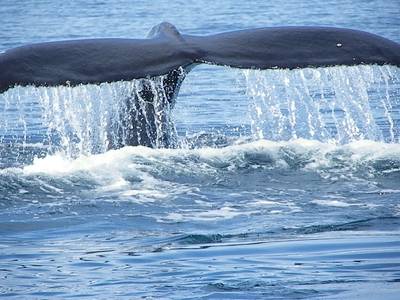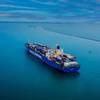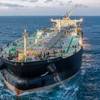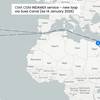North American Lobster Industry Confronts 'Ropeless' Traps After Whale Entanglements
An emerging technology to fish for lobsters virtually ropeless to prevent whale entanglements is exciting conservationists, but getting a frigid reception from harvesters worried it will drive them out of business and upend their way of life.
Injuries to endangered North Atlantic Right Whales ensnared in fishing gear have fueled a prominent campaign by environmental groups to pressure the industry to adopt on-demand equipment that only suspends ropes in the water briefly before traps are pulled from the water.
The Monterey Bay Aquarium’s Seafood Watch, which assesses the sustainability of fisheries, has put lobsters on a red list citing the threat to whales from ropes, prompting retailers like Whole Foods to stop selling them.
But lobster harvesters along the North American coast are less than impressed with idea of adopting the new gear. They argue it's expensive, faces the risk of technological glitches - and ultimately, does little for whales.
"My guess is for a lot of Maine lobstermen it is just a really scary idea," said Matt Weber, a lobsterman from Monhegan Island in Maine. "And it is all the more scary because none of us feel it is going to help (the whales)."
Since the start of the year, four North Atlantic Right Whales have been injured after getting entangled in fishing rope, according to government data, including one filmed in North Carolina trailing a pair of lobster traps that U.S. authorities believe came from the Canadian province of Nova Scotia hundreds of miles away.
Such entanglements have killed at least nine North Atlantic Right Whales since 2017, making it the second biggest cause of death behind strikes from boats and ships, according to the National Oceanographic and Atmospheric Administration.
That is a large number, given there are fewer than 350 North Atlantic Right Whales remaining, including just 70 breeding females, say regulators, researchers and conservationists. North Atlantic Right Whales who live off the eastern North American coast stretching from Florida to the Canadian Maritimes provinces are now on the verge of extinction.
To address the problem, the U.S. and Canadian governments have imposed new regulation on lobster and crab fisheries in recent years, including the use of weak links in rope that break if a whale swims through, color-coded rope for tracing, adding more traps per buoy line, and zone closures during whale migration.
But whales are still getting entangled.
“It doesn’t look like the solutions we’ve come up with are effective,” said Charles Mayo, senior scientist at the Center for Coastal Studies in Cape Cod, Massachusetts.
"Not effective to the point we need. We need a growing population. We don’t have that many whales left.”
Washington and Ottawa are now promoting ropeless fishing as a possible long-term solution. Traditional lobster fishing uses traps that sink to the ocean floor and are connected by a rope to a buoy floating at the surface. Ropeless gear, by contrast, only deploys a rope and buoy to the surface when its owner activates a release trigger by remote control.
NOAA published a strategy document in 2022 that envisions potential regulations for ropeless technology in coming years, and Canada’s Fisheries department has called ropeless gear “the only way you eliminate the vertical line entanglement risk.”
'Drastic over-response'
Rob Morris, a product line sales engineer for Edgetech, one of the handful of companies working on ropeless traps, said most of the technical issues around the equipment have been resolved – including reliability, viewing submerged gear on a chart plotter, and avoiding other people’s traps.
"This is pretty much fully developed,” he said. “We’re just making tweaks at this point.”
He said Edgetech was ready to make 100 units a month and was just waiting for industry orders.
But lobstermen, particularly in Maine where 80% of U.S. lobster is caught, are not enthusiastic.
The industry has long argued that not a single North Atlantic Right Whale death has been attributed to Maine lobster gear, and that the whales’ current migratory path puts them well east of the state’s lobster fishing grounds.
Lobster harvesters are also reeling from a public backlash due to whale entanglements and the red-listing by Seafood Watch last year, which marks a stunning fall from grace for an industry praised for decades for its sustainable practices.
“This seems to be a drastic over-response to something that didn’t happen here,” said lobsterman Kyle Murdock of Monhegan.
Lobstermen say they are concerned about the high overhead costs of switching to ropeless equipment, and fear inevitable technical glitches that could result in tens of thousands of dollars of traps lost at the bottom of the sea.
“I suppose there are lobstermen that would go ahead and do it and would invest the money. But I think it would be the end of Maine lobstering as we know it,” said Weber.
A handful of New England lobstermen are piloting ropeless equipment under special permits, mainly in Massachusetts. None of those lobstermen contacted by Reuters agreed to be interviewed.
Canadian trouble
In 2017, North Atlantic Right Whales began showing up in numbers in an unusual spot, Canada’s Gulf of St. Lawrence, east of where they normally would be seen.
Scientists say the shift from the usual summer destination of the Bay of Fundy was due to new currents, driven by climate change, that had pushed the whales’ food – small crustaceans called copepods – in that direction.
The result was tragic for the whales. Feeding in the midst of the Gulf’s busy shipping lanes and active snow crab and lobster fisheries, North Atlantic Right Whale deaths surged to 15 in that year alone, with five attributed to vessel strikes and the rest to either entanglements or unknown causes.
Brett Gilchrist, director of Fisheries and Oceans Canada, said Ottawa immediately implemented new measures to protect the whales, reducing ship speeds, and requiring the fishing industry to use weak rope links in their lines.
The government also began aerial and acoustic monitoring, allowing it to close areas to fishing when a whale is spotted. When the 2,100 square-kilometer zones are shut, only harvesters with ropeless gear are allowed to fish there, Gilchrist said.
“It's a bit of a challenge for our lobster harvesters for sure. But they also see that they're in it for the long term and this will help them secure their markets,” he said of the technology.
Michael Moore, a researcher at the Wood Hole Oceanographic Institution in Massachusetts, said the whales’ unexpected arrival in the Gulf of St. Lawrence showed how vertical line fishing everywhere might eventually have to adjust.
"As the climate changes, so too will the migration patterns," he said. "My hope is that we can actually broker a mutually sustainable solution to this problem. It is not impossible."
(Reuters - Writing by Richard Valdmanis; editing by Deepa Babington)













